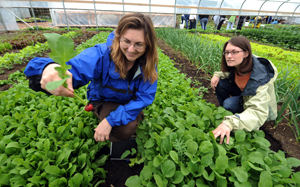Farm stand
Geophysicist Pamela Martin does the math to find out if small, local farms save energy over conventional agriculture.
By Lydialyle Gibson
Photography by Dan Dry
 Pamela Martin, ABí89 (left), and PhD student Esther Bowen, ABí08, are testing claims about local farming.
Pamela Martin, ABí89 (left), and PhD student Esther Bowen, ABí08, are testing claims about local farming. Pamela Martin, AB’89, grew up surrounded by corn and soybeans. In Dwight, Illinois, 80 miles southwest of Chicago, feed crops were everywhere: vast green fields with stalk upon stalk marching into the horizon. Martin’s family didn’t farm—her father had followed a job with R. R. Donnelley from Chicago to the area’s outskirts—and when she came back to the city for college, she didn’t expect to return to farm country.
Yet 25 years later, Martin, a geophysicist, spends much of her time ploughing through agricultural distribution logs and food-consumption data, talking to nearby urban and rural farmers about crop yields and labor hours, energy costs and cultivation methods. Working with geophysical-sciences graduate student Esther Bowen, AB’08, Martin is six months into a yearlong study to determine whether local, small-scale, organic farming beats conventional agriculture for energy efficiency. Common wisdom says yes. So do a growing number of green initiatives in cities across the country aimed at boosting investment in local farms. But almost no hard data exist one way or the other. “There are a lot of assumptions out there,” Martin says. “The first one is that local distribution is efficient, that it’s just as efficient as distribution from a distance. But that isn’t necessarily the case.”
 Growing Home, a half-acre farm on the South Side, is part of Martinís study.
Growing Home, a half-acre farm on the South Side, is part of Martinís study. To establish the raw data for her calculations, Martin gathers detailed records from a dozen local farming sites, logging everything that goes into the harvest: every tractor, every trailer, every bag of seed and gallon of gasoline, each piece of equipment, hour of labor, and dollar invested. The farmers also keep track of their yields, down to the last head of lettuce and bunch of carrots. Martin plans to convert those measurements to kilocalories and compare them with established figures for conventional farming. Other factors also play in: the amount of land left wild, energy savings from natural water filtration, extra hands needed to work less mechanized land.
Ranging from a half-acre to 40 acres, the farms in her study are diversified, meaning they grow a variety of crops. Six lie within Chicago city limits; one is in Kankakee, not far from her childhood home.
It didn’t take long to nudge Martin back to agriculture. As an undergraduate at Chicago, she majored in geophysical sciences—the closest she could get then to environmental studies—and went on to a geological-sciences PhD at the University of California, Santa Barbara, where she studied paleoclimate change. Charting the abrupt temperature spikes that melted glaciers 100,000 years ago led her to modern-day global warming. Proximity to California’s Central Valley got her thinking about agribusiness. The images stuck with her: workers fumigating strawberry fields in Tyvek suits, cattle standing atop heaps of manure, their grazing grounds degraded to a different ecosystem.
If small farming turns out to be more energy efficient, Martin believes it might also be a good way to save disappearing fields. “Farmland around the urban edges is probably lost at a greater rate than any other,” she says. “In Illinois, this is good soil that we’re losing to development.” Small, diversified farms might be more stalwart than corn-and-soy farms, “where the economic balance is, how are the subsidies looking this year? At some point it’s just going to tip over to development. Small-scale diversified is a growing market with lots of demand.”
Over the past several years, Martin and Bowen have studied whether it’s more energy-efficient to buy local or organic (local, in almost every case). And with former Chicago colleague Gidon Eshel, now at Bard College, Martin published a 2006 study quantifying the greenhouse-gas contributions of a typical omnivorous American diet.
Martin’s current research was prompted in part by a ten-day field study she and Eshel did with Chicago students, using records to track the “energy flows” at a small farm in New York state. “The numbers came out pretty similar for energy efficiency of food grown conventionally versus the small farm,” Martin says. “So I knew this was worth studying.” Students are also involved in the current project, which includes a yearlong course where undergraduates research regional food production and consumption. A dozen students are interns this summer at the farms, helping with record-keeping and the harvest.
By September, Martin hopes to be crunching numbers. Besides establishing a baseline for small, organic farms’ energy efficiency, she also hopes to identify fixable inefficiencies. Already she’s revealed a few—most surprising was amount of plastic ground covering some farms use to kill weeds. Organic rules prohibit reusing it. Martin also hopes to refine and continue the study, looking more closely at greenhouse-gas emissions and nutrient balances. “We want to know if it makes sense to develop this type of agriculture.”
WRITE THE EDITOR
E-MAIL THIS ARTICLE
SHARE THIS ARTICLE
RELATED READING
- "Recipe for Global Warming" (University of Chicago Magazine, Aug/06)
